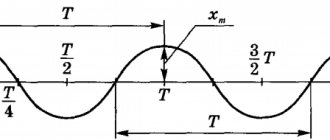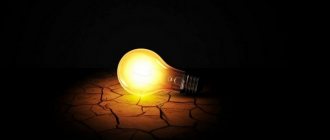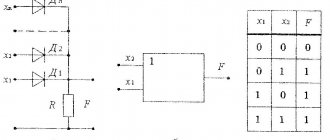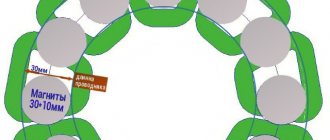Why is the sky blue and the grass green?
Actually, these are two questions, not one. And so we will give two different but related answers. We see a clear sky at midday blue because short wavelengths of light are scattered more efficiently when they collide with gas molecules in the atmosphere than long wavelengths. So the blueness we see in the sky is blue light scattered and reflected many times by atmospheric molecules.
But at sunrise and sunset the sky can take on a reddish color. Yes, this happens, believe me. This happens because when the Sun is close to the horizon, light has to travel a longer distance through a much denser (and dustier) layer of atmosphere to reach us than when the Sun is at its zenith. All short waves are absorbed, and we have to be content with the long ones, which are responsible for the red part of the spectrum.
But with grass everything is slightly different. It appears green because it absorbs all wavelengths except green. She doesn't like green, you see, so she reflects them back into our eyes. For the same reason, any object has its own color - we see that part of the light spectrum that it could not absorb. Black objects appear black because they absorb all wavelengths without reflecting anything, while white objects, on the contrary, reflect the entire visible spectrum of light. This also explains why black heats up much more in the sun than white.
The sky is blue, the grass is green, a dog is man's friend
Utorova Lilia
Senior lighting engineer
Works in the lighting industry since 2015. Graduate of the St. Petersburg Research University of Information Technologies, Mechanics and Optics. Favorite Quote: “There is no reason to feel alone when there is love and light in the world.”
Introduction
Every day throughout our lives, we are inextricably linked with light, which affects not only our visual perception of the world around us, but also our health, well-being, productivity and mood.
Since ancient times, by nature, a person wakes up at sunrise, when the sun is at its peak - he works, and with the onset of night he prepares for sleep. This is not accidental and is interconnected with light. How? To do this, it is necessary to consider the characteristics of light
Light radiation is characterized by such parameters as luminous flux, luminous intensity, brightness, illumination, etc., but I would like to dwell in more detail on the spectral characteristics and their relationship with nature.
Light is the visible region of electromagnetic radiation in the wavelength range from 380 nm to 780 nm. It is in this range that optical radiation can excite the human retina and create a visual image.
In addition to the visible region of radiation, ultraviolet (wavelength from 1 nm to 380 nm) and infrared radiation (wavelength from 780 nm to 1 μ) are also considered in lighting technology.
Visible radiation with different wavelengths is perceived by the eye as different colors:
Table 1. Wavelengths of different colors
| Wavelength | Color |
| from 380 nm to 450 nm | violet |
| from 450 nm to 480 nm | blue |
| from 480 to 510 | blue |
| from 510 to 550 | green |
| from 550 to 575 | yellow-green |
| from 575 to 590 | yellow |
| from 590 to 610 | orange |
| more than 610 | red |
The boundaries of colors are approximate - different people differ from each other in the perception of color signals by the brain. For us, the most obvious example of the visible spectrum in nature is the rainbow.
The full visible spectrum on a scale of radiation of different wavelengths looks like this:
White light is a mixture of all (or several) colors of the spectrum in a certain proportion. If a beam of white light is passed through a glass prism, it will decompose into a spectrum (the phenomenon of light dispersion).
We see different colors every day and do not attach importance to the fact that this is a very complex process of perception. The color of an object is determined by the spectral composition of light and the spectral characteristics of reflection and transmission of materials.
Color is an objective quantity that can be measured and expressed by specific parameters. To do this, the colorimetric chromaticity coordinate system is most often used:
In Fig. 3 shows a field of real colors. On the curved line bounding it, the wavelengths of monochromatic radiation perceived by the eye are marked - from 380 (violet) to 700 (red) nm.
The middle part of the color field is the area of white flowers. There is a line running through it - the thermal radiation curve, that is, the curve of the chromaticity coordinates of white light.
The color of white light depends on the color temperature - the temperature of a black body at which it emits radiation of the same background color as the radiation in question. Color temperature is measured in degrees Kelvin.
The color of the radiation from thermal light sources (incandescent lamps) very accurately matches this curve on the graph.
In Fig. Figure 4 shows a visual comparison of light sources with different color temperatures.
Many people make the mistake of believing that the higher the color temperature, the “warmer” the light, and the lower the color, the “cooler.” The association occurs with body and air temperature, when it becomes warmer as the temperature rises.
In the case of the color temperature of light, an analogy can be drawn with the color of stars.
The color of a star depends on the surface temperature: the more heat a star emits, the bluer its color, and vice versa, the coolest stars in terms of surface temperature are orange and red. As can be seen from Fig. 5, the hottest celestial bodies are blue stars with a temperature of 30000 K, the coldest stars are red with a temperature of 3500 K, the sun in the middle of the day has a surface temperature of 6000 K and a yellow-white color.
The influence of the color temperature of light sources on humans
In the modern world, most of our active time of the day is spent at the workplace, i.e. under the influence of artificial lighting. The quality of light and its sufficient quantity are an important component of a correct perception of the world around us. The shapes of objects, colors, people, perceived dangers are recognized by us if a sufficient level of illumination, exposure time and color are provided. Along with visual effects, color also affects other areas of human life.
Since the late 20th century, a large amount of research has been conducted on the non-visual effects of light on the body. It turned out that in the human eye there are not only known receptors - cones and rods, which reproduce images of objects, but also photoreceptors that perceive light without producing an image - melanopsin. These receptors are responsible for the production of the hormone melatonin, cortisol, regulating human circadian rhythms.
Circadian rhythms are the body's internal fundamental biological cycles with a 24-hour period, such as sleep, body temperature, and digestion. Circadian rhythms influence the production of the “sleep” hormone - melatonin, produce and align certain physiological reactions depending on the level of illumination and color temperature.
The hormone melatonin is responsible for rest and relaxation of the body and works in partnership with other hormones (cortisol, serotonin, dopamine). During the day, cortisol provides alertness and the body's stress response, serotonin controls impulse and carbohydrate cravings, and dopamine provides good mood, pleasure, alertness, and coordination.
High levels of melatonin cause sleepiness, but this can be regulated by influencing other hormones. Because While it is difficult to regulate the level of natural light during the working day, it is possible to influence these four hormones, and therefore circadian rhythms, through the correct choice of color temperature of artificial lighting sources.
The impact on human circadian rhythms occurs due to changes in the level of illumination and color temperature in certain phases of the day. For example, the blue spectral component suppresses melatonin and activates cortisol, which is suitable for the middle of the day, ensuring high human performance, mental and physical activity. Radiations in the yellow spectrum are suitable for the morning and evening, when the body relaxes and replenishes vitality. Thus, by changing the color temperature you can directly influence a person’s well-being, his mood and performance throughout the day, without disrupting life cycles.
Practical application of different color temperatures in artificial lighting
It has now become possible to put into practice the knowledge that lighting in the warm spectrum activates resting hormones and has a relaxing effect on the body, lighting in a neutral white color ensures comfortable performance of current tasks, and lighting in the cold spectrum promotes mental activity.
To achieve this, biologically and emotionally effective lighting can be provided in two ways:
- The first method is the effective distribution of lighting with different color temperatures over time and zones:
For example, a color temperature of light sources of 4000 K is suitable for standard working hours.
For meetings and important negotiations, a color temperature of 5000 K is required. Due to the cooler color temperature, the production of the hormone cortisol is activated, which leads to improved brain activity and concentration.
But during the working day, a person also needs rest to recuperate. For this purpose, a color temperature of light sources of 3000 K is provided in recreation rooms.
- The second way is to ensure the repetition of the daily solar cycle using light sources.
This method is based on the dependence of the natural solar cycle on the color temperature of radiation and the dependence of humans on the solar cycle. If you watch the sun during the day, you will see the following picture:
It is known that a person orients himself in time by natural light (the change of day and night), and that light has an impact on human biorhythms.
In the morning, when the sun rises (at a warm color temperature), melatonin production begins to decrease, and the body awakens. During the day (when moving from a neutral color temperature to a cold one), cortisol production increases performance. In the evening (at a warm color temperature), the production of cortisol decreases, melatonin increases, the body enters a state of rest and prepares for sleep. You can maintain a color temperature cycle in artificial lighting that is harmonious for the human body by organizing a programmed change in the color temperature of light sources.
Table 2. Dependence of the body on the color temperature of light sources
| Colorful temperature | What's happening | Effect |
| 2700 – 3000 K, warm | Production of the hormone melatonin, decreased production of the hormone cortisol | In the morning - waking up, in the afternoon - rest, relaxation, in the evening - getting ready for bed |
| 4000 – 5000 K, neutral | Production of the hormone cortisol, decreased production of the hormone melatonin | Basic working time – increasing concentration |
| 5000 – 6500 K, cold | Production of the hormone cortisol | Peak brain activity, concentration, attention and productivity |
Thus, by providing one approach to lighting control in the workplace, you can intelligently and positively influence the well-being and productivity of employees.
Trade lighting
Where else can you observe the influence of the color temperature of light sources on a person? In the shop. Yes, this influence does not change the buyer’s mood, but it helps to make a choice. With the right lighting, buns will look tastier and fish and meat will look fresher.
Currently, the question of which product to choose and in which store arises every day. The modern consumer, i.e. Each of us is surrounded by many stores competing with each other, but we will always go to the one where the product is better. And the product is better where it is presented correctly.
What is the relationship between product presentation and the spectral characteristics of light?
For trade lighting, an important requirement is the high-quality transmission of visual information about the product to the consumer, which can be achieved with the help of high-quality lighting. This is responsible for such parameters as a high level of illumination, a high color rendering index, correctly selected color temperature of the source and the use of special spectra.
Different groups of products require different lighting: there are special emission spectra of sources that emphasize the natural shades of objects.
For example, meat is illuminated with a red-shifted spectrum to make it look appetizing.
Frozen food and fish are illuminated with light with a cold color temperature (5000-6500 K), which emphasizes freshness, shine and coolness.
Bakery products are illuminated with warm light (2700-3000 K). As a rule, the bread is laid out on natural materials of warm colors (wood), which enhances the harmonious look.
Fruits and vegetables are illuminated with directional light with high color rendering to make the product look bright, fresh and attractive.
In table 3 shows additional types of goods that can also be emphasized favorably:
Table 3. Types of product range and the color temperature and spectrum shift they require
| Product range | Color temperature, K; Spectrum shift to color |
| Household goods | 3000 – 4000 K |
| Clothes and shoes | 3000 – 4000 K |
| Cars | 3000 – 4000 K |
| Chilled meat | 3700 K, red |
| Chilled fish | 5000 – 6500 K, blue |
| Fruits and vegetables | 2700 – 3000 K, yellow |
| Bakery products | 2700 K, yellow |
| Milk | 3000 – 4000 K |
| Sausage and smoked meats | 3700 K, red |
It is important to remember that providing a comfortable shopping environment is a complex and precise adjustment of various parameters of light sources, which should not be skimped on when designing, because a person will be more willing to make purchases in a store that he perceives as comfortable and with high-quality goods.
Conclusion
The article discusses the most important spectral characteristics of light sources, skillfully using which we can create a comfortable environment for our life and work.
Optimizing artificial lighting in the workspace helps maintain a person’s circadian rhythm, which directly affects well-being, mood and productivity.
Proper design of artificial lighting in stores, taking into account the requirements of various products, helps create a comfortable environment in the store and present products in the most favorable light to customers, which has a positive effect on sales.
Sources:
- "Reference book on lighting engineering", ed. Yu.B. Eisenberg, 3rd edition, 2006
- “Elementary lighting engineering”, L.P. Varfolomeev, 2013
- Magazine "Modern Lighting Engineering", No. 4, 2018
- Solutions booklet “Biologically and Emotionally Effective Lighting (Human Centric Lighting), Lighting Technologies, 2019
- Internet resource: v-kosmose.com
- Figures 4 and 6 are drawn and belong to bigpro.ru; the rest are taken from the Internet resource: pinterest.ru.
#light #spectrum #color temperature #article #recommendations #interior lighting #natural light
And what is there beyond the visible region of the spectrum?
As the waves get shorter, the color changes from red to blue to violet and finally visible light disappears. But the light itself did not disappear - it moved into the region of the spectrum called ultraviolet. Although we no longer perceive this part of the light spectrum, it is what makes fluorescent lamps, some types of LEDs, and all sorts of cool glow-in-the-dark things glow. Next comes X-ray and gamma radiation, with which it is better not to deal at all.
At the other end of the visible light spectrum, where red ends, infrared radiation begins, which is more heat than light. It could very well fry you. Then comes microwave radiation (very dangerous for eggs), and even further - what we used to call radio waves. Their lengths are already measured in centimeters, meters and even kilometers.
We're surrounded
Whether we realize it or not, we are in constant interaction with the world around us and accept the influence of various factors in this world. We see the space around us, constantly hear sounds from various sources, feel heat and cold, do not notice that we are under the influence of natural background radiation, and are also constantly in the zone of radiation that comes from a huge number of sources of telemetry, radio and telecommunication signals. Almost everything around us emits electromagnetic radiation. Electromagnetic radiation is electromagnetic waves created by various emitting objects - charged particles, atoms, molecules. Waves are characterized by repetition frequency, length, intensity, and a number of other characteristics. Here's just an introductory example. The heat emanating from a burning fire is an electromagnetic wave, or rather infrared radiation, and of very high intensity; we do not see it, but we can feel it. The doctors took an X-ray and irradiated him with electromagnetic waves that have a high penetrating power, but we did not feel or see these waves. Of course, you all know that electric current and all devices that operate under its influence are sources of electromagnetic radiation. But in this article I will not tell you the theory of electromagnetic radiation and its physical nature, I will try to explain in more or less simple language what visible light is and how the color of the objects that we see is formed. I started talking about electromagnetic waves to tell you the most important thing: Light is an electromagnetic wave that is emitted by a heated or excited substance. The role of such a substance can be the sun, an incandescent lamp, an LED flashlight, the flame of a fire, or various types of chemical reactions. There can be quite a lot of examples; you yourself can give them in much greater quantities than I wrote. It is necessary to clarify that by the concept of light we mean visible light. All of the above can be represented in the form of a picture like this (Figure 1).
Figure 1 – Place of visible radiation among other types of electromagnetic radiation.
In Figure 1 visible radiation
presented in the form of a scale, which consists of a “mixture” of different colors.
As you may have guessed, this is a spectrum
. A wavy line (sine curve) runs through the entire spectrum (from left to right) - this is an electromagnetic wave that reflects the essence of light as electromagnetic radiation. Roughly speaking, any radiation is a wave. X-ray, ionizing, radio radiation (radio receivers, television communications) - it doesn’t matter, they are all electromagnetic waves, only each type of radiation has a different length of these waves. A sine wave is simply a graphical representation of radiated energy as it changes over time. This is a mathematical description of emitted energy. In Figure 1, you can also notice that the depicted wave seems to be slightly compressed in the left corner and expanded in the right. This suggests that it has different lengths in different areas. The wavelength is the distance between its two adjacent peaks. Visible radiation (visible light) has a wavelength that varies from 380 to 780nm (nanometers). Visible light is just a segment of one very long electromagnetic wave.
And how does all this relate to lighting?
Very relevant! Since we have learned a lot about the spectrum of visible light and how we perceive it, lighting equipment manufacturers are constantly working to improve the quality of light sources to meet our ever-growing needs. This is how “full spectrum” lamps appeared, the light of which is almost indistinguishable from natural light. The color of light began to be measured on the Kelvin scale in order to have real numbers for comparison and marketing tricks. Special lamps began to be produced for various needs: for example, lamps for growing indoor plants, giving more ultraviolet and light from the red region of the spectrum for better growth and flowering, or “heat lamps” of various types, which settled in household heaters, toasters, and grills in "Shaurma from Ashot."
What kind of light is there?
Light flow
Brightness is the strength of luminous flux in a certain direction. The above information confirms the need to take into account other factors for a thorough analysis of practical radiation parameters.
Colorful temperature
Depending on the perception, the following scale for the distribution of spectrum ranges in Kelvin (K) is used:
- warm color – 2650-3600;
- natural (neutral) – 3700-4900;
- cold – more than 5000.
What parameters are used to measure light intensity?
Lumen is a unit of measurement of luminous flux
What brightness is is clear from the above formulations. However, as the source moves away from the observer, the luminosity decreases. An initially small spot on the surface where the beam was directed increases with a simultaneous decrease in intensity.
To take into account the noted changes, the concept of illumination (E) was introduced. In the simplest example, for a point source the formula is valid:
E=(I/r2) * cos u,
Where:
- I – luminous intensity;
- r is the distance between the source and the surface;
- u is the angle of inclination of the rays.
T. Jung's experience
To demonstrate the phenomenon of interference and to determine the wavelength of light, T. Jung performed a special experiment.
To obtain a clear interference pattern, it is necessary to have two coherent light beams, that is, beams that have the same wavelength and have a constant phase difference. By illuminating two close slits, it is possible to obtain conditions for the addition and subtraction of light waves behind them on the screen - interference. The main idea of Young's experiment was to use not a simple light beam to illuminate the slits, which was used by researchers before Young, but a beam passing through a small hole, behind which, in accordance with Huygens' principle, a single coherent wave will be excited, and it is this that should used to illuminate two slits to produce an interference pattern behind them.
Rice. 2. Jung's experience of interference.
Law of rectilinear propagation of light
Any student who has entered grades 9-11 should know that light in a homogeneous medium travels along a straight path, and its speed is 3x10 8
m/s
. At this speed, the beam travels from the Earth to the Moon (the distance between them is 384,000 kilometers) in just about 1.2-1.3 seconds!
Based on the rectilinear propagation of light, many concepts are derived, such as shadow, angle of incidence and reflection, and much more. Different branches of science use these data differently, but they are of great importance in technology and theory.
To summarize, we will say that the lexical meaning of the Greek word “photon” clearly conveys its meaning - this is light. Light is both an electromagnetic wave and a stream of photon particles that propagate from the radiation source and fill the entire surrounding space according to the laws of rectilinear propagation, diffraction, interference, etc.
Both natural and artificial lighting have the same properties, with the exception of the wavelength, its amplitude and other, more specific characteristics of each wave.
How is the intensity of light measured?
Since you can see products from different manufacturers on sale, mistakes are possible in the process of studying the accompanying documentation. To avoid problems, it is recommended that you familiarize yourself with the terminology used.
What is "candela"
A single parameter (1 candela) corresponds to the illumination of the surface with a low-power luminous flux (1/689 W/st). The frequency of electromagnetic radiation is fixed – 540 * 1012 Hz.
Lumens and Luxes
Lux (lx) measures the brightness at the site. One lux produces a luminous flux of 1 lumen (lm), which falls perpendicularly to the surface. To measure, take a base area of 1 square meter.
Lumen and Watt
The complex indicator, luminous efficiency, is discussed above. However, comparisons can be made by the lumens that a particular source produces and the amount of energy consumed in Watts.
Multiples of Lumen Units
For the convenience of measuring and recording the obtained data at high light intensity, multiple prefixes are used:
- kilo – 103;
- mega – 106;
- giga – 109.
Lumen subunits
Proceed similarly when working with small quantities:
- milli – 10-3;
- micro – 10-6;
- nano – 10-9.
How is the brightness of light measured?
The current unit of measurement for light (brightness) is candela per square meter. The previous unit of brightness is “nit”. This parameter determines the ratio of the intensity of the light flux to the projection of the beam onto a platform located at an angle of 90 degrees to the real observation axis.
The unit of brightness of a luminous surface is determined by the ratio of the illumination level to the solid angle (elementary). It is understood that it is within these limits that the flow that creates the glow on the surface is contained. It is installed perpendicular to the source.











